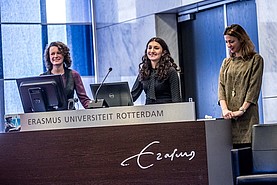PhD Defence: Implementation and Impact of ISO 9001

In her dissertation the ‘Implementation and Impact of ISO 9001’ ERIM’s Başak Manders examines the effectives of ISO 9001 adoption, since its initial creation in 1987 to the run-up of an introduction of a new version in 2015. Noting that current literature provides mixed results regarding the operational and market benefits of ISO 9001 adoption, Başak seeks to provide a definitive answer to the debate. Başak confirms that national differences, such as national culture and level of economic development, impact the effectiveness of ISO 9001 adoption, and reveals further predictive variables at both the organizational and employee level.
Başak defended her dissertation in the Senate Hall at Erasmus University Rotterdam on Friday, 30 January 2015. Her supervisor was Professor Knut Blind and her co-supervisor was Professor Henk de Vries. Other members of the Doctoral Committee included Doctor Daan Stam (ERIM), Professor Kevin Linderman (Carlson School of Management), and Professor Mohan Tatikonda (Kelley School of Business).
About Basak Manders

Başak Manders (1987) obtained her Bachelor’s degree in Manufacturing Systems Engineering from Sabanci University, Istanbul/Turkey in 2009 with Honors. She received her Master’s degree (MPhil) in Logistics and Information Systems from Rotterdam School of Management, Erasmus University in 2011 with cum laude. In October 2011, she started her PhD project in the Technology and Operations Management department. Her research interests include quality management and business process improvement. As a part of her PhD project, she spent three months as a visiting scholar at Carlson School of Management, University of Minnesota. She presented her research findings at several international conferences including AOM (2013, 2014), POMS (2014), DSI (2014), EUROMA (2013), EURAM (2013) and EURAS (2012). She won the national research award in quality management for her Master’s thesis “The financial impact of ISO 9000 certification: a meta-analysis” from the Dutch network for quality management, NNK (Nederlands Netwerk voor Kwaliteitsmanagement). She also won the Academy of Management Operations Management Division best reviewer award in 2014. She serves as a reviewer for various journals and conferences including Journal of Operations Management, International Journal of Operations and Production Management and AOM.
Thesis Abstract

The ISO 9001 quality management standard has been implemented by more than one million organizations in 187 countries since its introduction in 1987. A newer version of ISO 9001 is planned to be introduced in 2015. Even though it is widely used by organizations to gain both operational and market benefits, the studies on the impact of ISO 9001 report mixed findings. Therefore, the aim of this dissertation is to find out what is the impact of ISO 9001, and to better understand the differences in current literature.
The findings demonstrate that ISO 9001 leads to operational and market benefits in the majority of cases. We also show that the benefits gained from ISO 9001 differs depending on the length of the period since certification, standard version, geographic location, industry sector, and company size. We further demonstrate that national differences, specifically the level of economic development and national culture, impact the performance benefits of ISO 9001. Moreover, we find that not all of the employees in a company use ISO 9001 in their daily work. Having a positive attitude towards ISO 9001 usage, being aware of ISO 9001, believing that ISO 9001 is useful and easy to use, and feeling responsible for ISO 9001 discriminated employees that did participate in ISO 9001-related practices from those that did not.
Together, these three chapters illustrate that the relationship between ISO 9001 and business performance is not as straightforward as it is often assumed. Our findings indicate that the implementation and the impact of ISO 9001 can be studied and explained at three different levels: Country level, company level and employee level.
Photos: Chris Gorzeman / Capital Images


